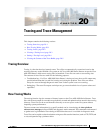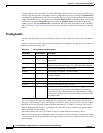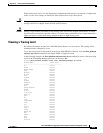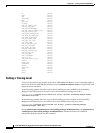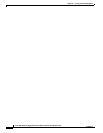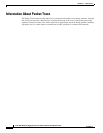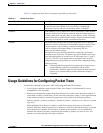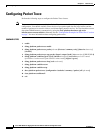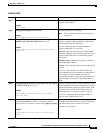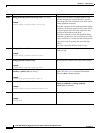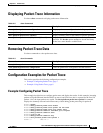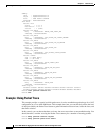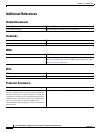
21-3
Cisco ASR 1000 Series Aggregation Services Routers Software Configuration Guide
OL-16506-17
Chapter 21 Packet Trace
Usage Guidelines for Configuring Packet Trace
Table 21-1 explains the three levels of inspection provided by packet trace.
Table 21-1 Packet-Trace Level
Usage Guidelines for Configuring Packet Trace
Consider the following best practices while configuring the Packet-Trace feature:
• Use of ingress conditions when using the Packet-Trace feature is recommended for a more
comprehensive view of packets.
• Packet-trace configuration requires data-plane memory. On systems where data-plane memory is
constrained, carefully consider how you will select the packet-trace values. A close approximation
of the amount of memory consumed by packet trace is provided by the following equation:
memory required = (statistics overhead) + number of packets * (summary size + data size + packet
copy size).
When the Packet-Trace feature is enabled, a small, fixed amount of memory is allocated for
statistics. Similarly, when per-packet data is captured, a small, fixed amount of memory is required
for each packet for summary data. However, as shown by the equation, you can significantly
influence the amount of memory consumed by the number of packets you select to trace, and
whether you collect path data and copies of packets.
Packet-Trace Level Description
Accounting Packet-Trace accounting provides a count of packets that enter and leave
the network processor. Packet-Trace accounting is a lightweight
performance activity, and runs continuously until it is disabled.
Summary At the summary level of packet trace, data is collected for a finite number
of packets. Packet-Trace summary tracks the input and output interfaces,
the final packet state, and punt, drop, or inject packets, if any. Collecting
summary data adds to additional performance compared to normal packet
processing, and can help to isolate a troublesome interface.
Path data The packet-trace path data level provides the greatest level of detail in
packet trace. Data is collected for a finite number of packets. Packet-Trace
path data captures data, including a conditional debugging ID that is
useful to correlate with feature debugs, a timestamp, and also
feature-specific path-trace data.
Path data also has two optional capabilities: packet copy and Feature
Invocation Array (FIA) trace. The packet-copy option enables you to copy
input and output packets at various layers of the packet (layer 2, layer 3
or layer 4). The FIA- trace option tracks every feature entry invoked
during packet processing and helps you to know what is happening during
packet processing.
Note Collecting path data consumes more packet-processing resources,
and the optional capabilities incrementally affect packet
performance. Therefore, path-data level should be used in limited
capacity or in situations where packet performance change is
acceptable.



